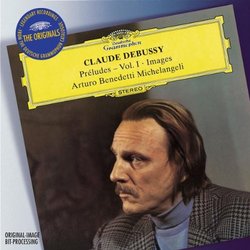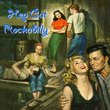| All Artists: Claude Debussy, Arturo Benedetti Michelangeli Title: Claude Debussy: Préludes, Vol. 1; Images Members Wishing: 0 Total Copies: 1 Label: Deutsche Grammophon Release Date: 3/8/2005 Genre: Classical Styles: Chamber Music, Historical Periods, Classical (c.1770-1830) Number of Discs: 1 SwapaCD Credits: 1 UPC: 028947753452 |
Search - Claude Debussy, Arturo Benedetti Michelangeli :: Claude Debussy: Préludes, Vol. 1; Images
 | Claude Debussy, Arturo Benedetti Michelangeli Claude Debussy: Préludes, Vol. 1; Images Genre: Classical
![header=[] body=[This CD is available to be requested as disc only.]](/images/attributes/disc.png?v=430e6b0a) ![header=[] body=[This CD is available to be requested with the disc and back insert.]](/images/attributes/disc_back.png?v=430e6b0a) ![header=[] body=[This CD is available to be requested with the disc and front insert.]](/images/attributes/disc_front.png?v=430e6b0a) ![header=[] body=[This CD is available to be requested with the disc, front and back inserts.]](/images/attributes/disc_front_back.png?v=430e6b0a) |
Larger Image |
CD DetailsSimilar CDs
|
CD ReviewsMichelangeli Super-Virtuoso, Plays With Pianistic Polish An Raymond Vacchino | Toronto, ON. Canada | 10/22/2007 (5 out of 5 stars) "Michelangeli's unique creative touch made him somewhat of a "Prophet" to the new art of Debussy. 1. Danseuses de Delphes: This prelude turns to antiquity, to the dances at the Temple of Apollo at Delphi, an evocation of a fragment of sculpture, perhaps. The very nature of the three levels of musical development gives the basic clue to its interpretation. Michelangeli conveys the melody in a softly sustained, expressive manner leaving it open to rhythmic developments. The frame chords are gently detached, impersonal, opposed in effect to the expressive melody. The playing also has an incisive approach to the metallic crotals, that carry a resonant tone, ringing with multiple harmonies, vibrating in even larger circles around their fundamental tones, with the soft pedal being used in the opening measures. 2. Voiles: In this performance one notes that the quality of touch and pedaling takes into account the three distinct levels upon which the whole prelude is built. Michelangeli defines the individual personalities and their capacities when first stated and retains these characteristics when superimposed upon each other. In order of importance the three levels are the melody, the ostinato and the pedals least, since their expressive possibilities are the least developed. Michelangeli provides the sought diversity of the levels contrasted to each other. Within the first two he obtains differentiation in dynamics for the point of tension and those of release, and pedaling which does not mix appogiaturas with their resolutions. 3. Le Vent sur la plaine: Here we sense the wind blowing constantly over the plains, with an occasional threatening gust in strong contrast to the terror evoked by the west wind of the 7th prelude. Michelangeli keeps the sounds of the opening trill distinct, of which various forms are used nearly throughout the prelude. 4. Les sons et les Parfums Tournent Dans L'air du soir: In between the sounds and perfumes of Baudelaire's poem, Michelangeli conveys their musical counterpart in Debussy's intoxicating 4th prelude, with the overheard distant horn calls at its conclusion. He plays with considerable richness of rhythm and dynamics despite the subdued level of the entire piece. 5. Le Collines D'Anacapri: Michelangeli impressively develops a resonant tone in the introduction, not harsh or loud but long in its vibrations for the bell tones, held by the pedal. In contrast, through still light, the motifs from the tarantella can already be heard getting sharper, gaining dynamically the second time. In the minor passage the material is much more expressively conveyed and carefully phrased. Observe the certain freedom in the 2nd theme, this popular material is nostalgic, romantic, but easy to overdue. Michelangeli does not shy away from the unparalleled brilliancy of the last few measures, (fff) it is the crowning of the joyous exuberance of the dance, the landscape, the glaring, baltant sun. 6. Des Pas Sur La Neige: This prelude is conceived at three contrapuntal levels: the footfalls forming an ostinato, a psychological and pictorial canvas. Michelangeli wonderfully shapes the melody, expressing emotional fluctuations, the pedal-points steadily coloring the two other levels. 7. Ce Qu'a vu le vent d'Quest: Note the extremes of dynamics used by Michelangeli in the performance, they must not be underrated. He turns these dynamic extremes into conveying the cruel sea. The music is more angular and fragmentary than even La mer. This prelude has the quality of the Erlkonig, the "Sturm und Drang" of romantic literature. 8. La fille aux cheveus de lin: In the most familiar of the preludes, the young girl singing in the morning sunshine in Leconte de Lisle's poem, is, in fact, Scottish. Scotland was as distant and exotic an inspiration for the impressionists as were Italy, Spain, the orient and ancient Greece. Michelangeli makes this short prelude sing calmly,in diametric contrast to the preceding turmoil of the western wind. It remains fresh and young, for these two qualities are its very essence. 9. La Serenade Interrompue: Observe that much of the mocking charm comes from the abrupt nature of the interruptions, and that clear levels of differences in dynamics must parallel the differentiated musical textures. Michelangeli creates the dryness and brittleness of the guitar effectively by making very little use of the pedal. Its use is extremely limited throughout, with only fragments of the second material pedalled, still sparingly. 10. La Cathedrale engloutie: Michelangeli gives a shimmering performance. The playing gives full consideration to the differentiations of levels and touch to be applied to the bells (resonant, slap touch). He allows us to envisage the necessity in pedaling, touch and length of motions, weight of minute variations, from the misty calm of the opening, through the gradual emergence of the Cathedral to the sonorous apex of its victory over the sea, and the receding, engulfing process of the last sections. 11. La Danse de Puck: Michelangeli is cunning in his approach to this titillating role. He creates a tormenting meddler in the fairy kingdom of the forests better known as Puck. The texture is scherzando, there ending the resemblance for this prelude to "A Midsummers Night's Dream." This prelude is both deeper in meaning and lighter in touch than its romantic counterpart. Puck's fleeting antics lead us to the final prelude, with its fast-changing glimpses of an early 20th century music hall show. 12. Minstrels: Here, travelling minstrels with their blackened faces, top hats and white coat-tails go through their routine in music reminiscent of Debussy's earlier Golliwog's Cake Walk. Michelangeli plays with the necessary detached touch needed in the ornaments of the first section, and played on the beat. Similar passages are very detached whereas succeeding parts allow for a certain amount of legato and rubato. Michelangeli observes that precision and sharpness must reassert themselves from the end of m.14. In the drum episode, note the accents. Freedom is in order for the sentimental song, but at the tempo primo of the last page, strictness must be maintained and in the acceleration of the last few bars, the notes beat a clipped tattoo in rapid succession. Michelangeli's fingers can no more hit a wrong note or smudge a passage than a bullet can be veered of course once it has been fired. He is a complete master of tonal application, as evidenced in his performance of Gaspard de la Nuit. Author:Raymond Vacchino M.Mus.(MT) A.Mus. L.R.S.M. Licentiate (hon.)" A brilliance all his own Mark Hennicke | A stone's throw from Carnegie Hall | 02/29/2008 (5 out of 5 stars) "To say Arturo Benedetti Michelangeli was a unique talent in the world of classical music is, by every stretch of the imagination, an understatement. Perhaps no pianist we've ever heard displayed so much stunning technical brilliance along with a genius for interpretive insight. These marvelous gifts are captured wonderfully on this cd of piano works by Claude Debussy. The Preludes Book One are deeply insightful readings that hold the listener in rapt moments of thoughtful introspection, though at times they can be ever so slighltly frenetic ( Michelangeli does have his idosyncracies from time to time.) The Images Books One & Two are beautifully thoughtful as well, but in a more contemplative fashion. Still waters run quite deep in many a Michelangeli performance, though one often finds this to be the case with truly great musicians. They easily perceive things that we mere mortals often have difficulty comprehending. Thank goodness that when it comes to deeply emotional music, like that of Claude Debussy, we have able guides like Arturo Benedtti Michelangeli to show us the way." Desert Island Disc Garry Feeney | Sydney. Australia | 10/04/2009 (5 out of 5 stars) "I wish I could find adequate words to do justice to this recording but I doubt that anyone can. If you are familiar with the music, you probably already own this version. If not, you need to get yourself a copy. Words I could use would include masterful, elegant, brilliand and ultimately beautiful. Blissful! I completely lose myself in this wonderful music when I play this recording. If you are someone unfamiliar with this music, this recording will win you over."
|

 Track Listings (18) - Disc #1
Track Listings (18) - Disc #1

